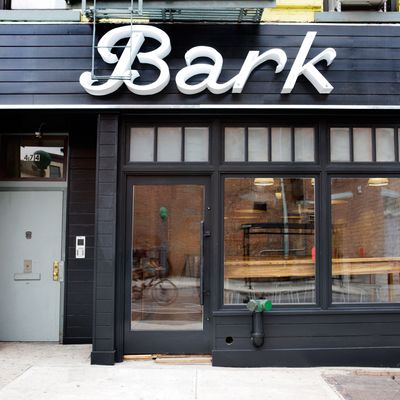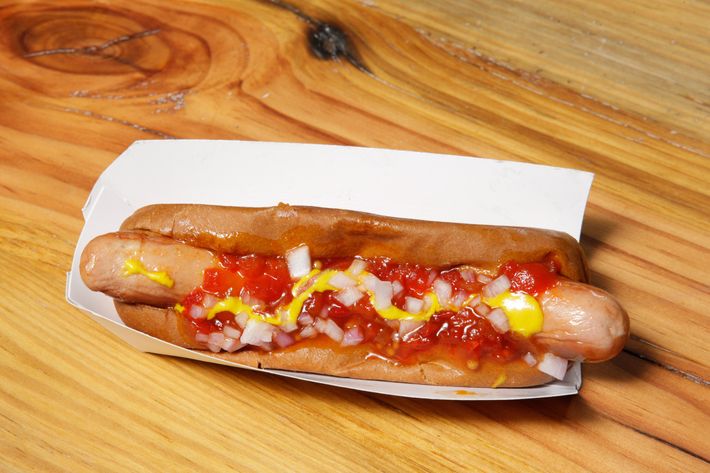
Since opening in Park Slope in 2009, Bark Hot Dogs seemed to have all the hallmarks of a successful fast-casual business: a simple, focused menu; high-quality, local ingredients; a sleek space filled with reclaimed wood; and consistently great press. (Not to mention, of course, what looked like a steady stream of customers.) But this fall, Bark opened and closed a Bleecker Street outpost within six months, and, earlier this month, owner Joshua Sharkey really took people by surprise when he announced the closure of the original Brooklyn location. What gives? Sharkey says, in part, he made the call because of rising food costs and a continued dip in sales — which he first attributes to Shake Shack opening near the Barclays Center. Here, he explains:
How was Bark’s final weekend in service?
Good! Really crazy, actually. So busy. You know, it was expectedly very busy. Everybody was trying to get their last fix of Bark.
My co-workers were shocked and saddened to hear the news.
Yeah, I think pretty much everyone was certainly sad and definitely shocked as well.
So what led you to this decision?
Well, I think it wasn’t any one particular thing. You know? In general, the cost of business has just gone up so much in the past few years for us. And with our business model, we try to keep as low of a price point as we can. For a fast-casual, quick-service type of business, we use pretty expensive products, and they’re just getting a little more expensive, especially the local beef and pork. And the economics were just getting really hard, and, you know, we had a pretty tough go of it in Manhattan. The sales weren’t quite where we needed to be, but they were increasing every week. And there were just a lot of other factors that I unfortunately can’t go into at the moment, because we’re still dealing with them, but they caused us to close on Bleecker.
And that sort of caused me to really think about the future of Bark. We’re looking to roll out a retail part of the business: packaged hot dogs, condiments, things like that. That’s something that we’ve actually been working on for quite a while. And, you know, I was just sort of reviewing our space here in Brooklyn and the future of the next five or ten years here. It just made a lot more sense, with how the economics were changing for us, to close it down and be able to focus more on getting this retail arm of the business going. We want to have a sustainable business. It just became so much harder to do so in a brick-and-mortar space.
I remember reading that, with your Bleecker Street store, you said the rent turned out to be too high to manage.
Rent always plays a role in any business, of course. But that was certainly not the reason why we closed. It was part of the reason why we closed. We knew the rent going in there. We knew what we had to do in terms of sales to make the rent. And we were in a position when we opened, unfortunately, some other factors were — we were starting from a tough spot. The rent did play a part, but it was certainly not the entire reason we closed.
How much would you estimate that your food costs have gone up in the past few years?
Oh, wow. I mean, the beef and the hot dogs have always gone up a lot. You know, getting local — honestly, just the hot dogs alone have gone up substantially. We’re using good-quality meat.
Do you have any idea of a percentage?
Since we’ve started, probably, like, 5 to 8 percent per year. And if you compound that over seven years … we haven’t raised our prices once since day one.
So why not raise the prices?
The “why not” is really a big crux of one of our struggles with this concept. You know, it is quick service, and there is a perception of cost. That’s something that we’re constantly struggling with — that there’s a perceived cost that the product should be. There are other much bigger quick-service brands that use hot dogs that are maybe mass-produced, which cost much less. Ours is not that. So there’s obviously a cost difference there, but it’s tough for a product that’s so simple but also so prevalent in American culture. Everyone knows what a hot dog is, and there’s an expected price. And I also don’t feel comfortable charging any more than we already do for a hot dog. But unfortunately, in terms of a brick-and-mortar operation, that cost would really need to go up. I didn’t really feel comfortable raising prices more than we already have.

You were one of the early fast-casual success stories: You elevated a simple food item and received so much good press. And now every chef is trying to do that, with every food item imaginable. Did you feel that heat as the years went on and competition increased?
Well, I think, if anything, that was always better for us. When we opened, for better or for worse, there really wasn’t anyone that was doing what we were doing. At least in the New York area. So there’s a learning curve there, with customers, to just sort of understand that they’re coming into a place that’s not something they’ve ever had before.
Yeah, it’s not Gray’s Papaya.
Exactly. And there’s a cost of educating the customer on that. And as more places opened similar to this — similar in values and model and price point — more and more consumers started to realize, Yeah, you can have great food and have it be simple and casual. And I think, in a lot of ways, that helped us. Of course, in the New York climate there’s so much competition that it’s always going to also play a factor on the opposite end of the spectrum. Where there’s only so many people that live in an area, and there are so many seats and restaurants in that area, you can only reach those people so often. Especially in Brooklyn, where it’s not nearly as much foot traffic. And I don’t think that hot dogs typically are a weekly thing for a lot of people? I think it’s more like a treat.
Yes, that makes sense. But it did always seem like you were busy.
We were busy, and we had a great loyal following. It was so amazing to see all those people this past week, all at once. But we were just not busy enough for what we needed to do in New York. You know, being busy isn’t enough. Especially with the low price point. The volume has to be really high. It just wasn’t enough to sustain the business
When did your sales start to drop?
Our sales were pretty constant for the first two years. And then we did see a pretty dramatic drop when Shake Shack arrived. That was the most clear and present change. Literally in a matter of a month or so, we saw a pretty big drop-off. We actually took this space knowing that the Barclays Center was coming in. Shake Shack just happened to be across the stadium, and we were down the block. Before they opened, we had every event. You know, we were packed to the gills. And that started to dissipate after it opened.
How big of a dip, would you say, numbers-wise?
Honestly? Almost 18 percent for the first few months. And then that started to soften a bit. So it was dramatic at the beginning, which we would have to assume, right? Because Shake Shack is new to the neighborhood, and everyone wants to try it. And then it trickled to around 12 to 14 percent lost in sales.
When did you begin thinking about actually closing in Brooklyn?
It was probably at least several months in the making. You know, we didn’t decide yesterday.
What kind of reactions have you seen?
People are definitely sad. We are getting really, really beautiful messages and emails coming in. And calls. And, of course, posts on social media. But honestly, one of the things I loved most about being in this neighborhood was that because we have this environmental and social element of our business, we attract a lot of families. I’ve seen kids that came here 6, 7 years ago, and they were just little toddlers. Seeing them grow up over the last six years and learn about food and composting — that’s been tremendous. And I’m getting so many emails from people saying like, “I met my fiancé here!” or “We had our first date here.” It’s been bittersweet, for sure. But it’s been really great to see the impact we’ve had in the community.
What’s your plan now? You mentioned the retail component.
We’re looking to finish designing some packaging and things like that. The goal is to start with hot dogs in as many stores as we can. Of course, we’ll start in New York and hopefully grow from there. It’s probably going to be a month or so of just winding down now in the store before we start to amp up again, but our goal is to be rolling that out by spring.
Do you think you’ll ever open up a brick-and-mortar restaurant again?
I would never rule that out, for sure. But I think right now, in the immediate future? I would say not anything in the immediate future. But never say never.




